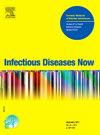Value of molecular biology tests in community-acquired acute pneumonia
IF 2.2
4区 医学
Q2 INFECTIOUS DISEASES
引用次数: 0
Abstract
For patients hospitalized with community-acquired acute pneumonia (CAP), molecular tools (especially multiplex PCR syndromic panels) are associated with a significant improvement of microbiological diagnosis yield, compared with conventional methods. Two main families of tests are currently available: targeted viral PCR tests (influenza, SARS-CoV-2, RSV) performed on nasopharyngeal swabs and adapted to epidemic situations; and “upper respiratory tract” (nasopharyngeal) or “lower respiratory tract” (deep swabs) syndromic panels to detect a broad spectrum of viral and bacterial agents, sometimes including resistance genes.
These tests are not recommended for routine use in CAP patients treated in ambulatory settings. In hospitalized CAP patients, their use must be guided by severity, epidemic context, and therapeutic implications. “Upper respiratory tract” panels can be useful when an atypical agent or a virus undetected by targeted PCR tests is suspected. “Lower respiratory tract” panels must only be used in case of severe forms or complex situations.
Clinical trials showed real diagnostic value but variable clinical impact, which is often limited in the absence of an optimization strategy for the antibiotic therapy.
Multiplex PCR syndromic panels represent a promising step forward in the management of patients hospitalized with CAP, but their clinical value still depends on several factors: type of panel and swab, quick results, presence of mobile teams of infectious diseases specialists, and capacity to correctly interpret results to guide treatment decisions.
分子生物学检测在社区获得性急性肺炎中的价值
对于社区获得性急性肺炎(CAP)住院患者,与传统方法相比,分子工具(尤其是多重PCR综合征面板)与微生物诊断率的显著提高相关。目前可用的检测方法主要有两大类:针对鼻咽拭子进行的靶向病毒PCR检测(流感、SARS-CoV-2、RSV),适用于流行情况;以及“上呼吸道”(鼻咽)或“下呼吸道”(深拭子)综合征组,以检测广泛的病毒和细菌病原体,有时包括抗性基因。不建议在门诊治疗的CAP患者常规使用这些检查。在住院的CAP患者中,必须根据病情严重程度、流行背景和治疗意义来指导其使用。当怀疑有非典型病原体或目标聚合酶链反应试验未检测到的病毒时,“上呼吸道”面板可能有用。“下呼吸道”面板只能在严重或复杂的情况下使用。临床试验显示了真实的诊断价值,但临床影响不同,这往往是有限的,缺乏优化策略的抗生素治疗。多重聚合酶链反应综合征小组代表着在CAP住院患者管理方面向前迈出的有希望的一步,但其临床价值仍取决于几个因素:小组和拭子的类型、快速结果、传染病专家流动小组的存在,以及正确解释结果以指导治疗决策的能力。
本文章由计算机程序翻译,如有差异,请以英文原文为准。
求助全文
约1分钟内获得全文
求助全文
来源期刊

Infectious diseases now
Medicine-Infectious Diseases
CiteScore
7.10
自引率
2.90%
发文量
116
审稿时长
40 days
 求助内容:
求助内容: 应助结果提醒方式:
应助结果提醒方式:


